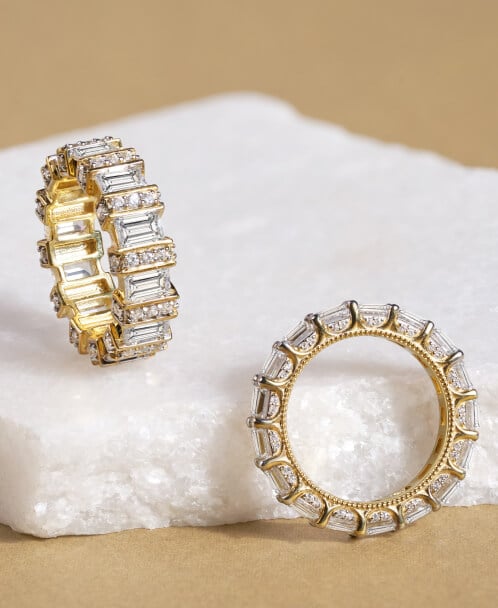The history of diamonds traces back thousands of years, with the earliest known diamonds discovered in India around 2,500 years ago. Even the phrase, “Diamonds are forever,” had been coined to increase the hype around the precious stone.
Prized by Indian rulers as divine objects, these rough diamonds were initially kept as talismans before being incorporated into jewelry worn predominantly by men. Now, lab diamonds have become the need of the hour. These ethical and sustainable alternatives to the naturally mined diamonds are in every way similar to their counterparts.
Table of Contents
Myths Related To Diamonds
Diamonds made their way to the West through the expansion of trade routes, where they came to represent rank and prosperity. During the Middle Ages, diamonds were used as amulets and talismans in India because of the belief that they had magical and therapeutic qualities. They were also known as the weapon of Gods in Sanskrit.

SHOP LOOSE DIAMONDS
The Pharaohs of Egypt used the diamond as the center of the ankh, which was a cross that had a loop at the top of it. The diamond was a symbol of the sun, power, courage and truth. The ankh was the Egyptian hieroglyph for life.
The ancient Greeks and Romans had great beliefs about diamonds. They believed that diamonds were in reality, the tears of God. They also thought that diamonds were the splinters of falling stars. Did you know that classical Greek philosopher Plato had written about diamonds as living beings that embodied celestial beings.
Another Greek legend about diamonds was that Chronos had changed a young man into Adamas, and thus made him invincible. The diamond was seen as an antidote to poison and there were even used as medicines. Kings in ancient Greek went to war wearing diamond studded breastplates.
Diamonds were employed by Jewish high priests to judge an accused person's guilt or innocence. The diamond in front of someone would sparkle more the more true they were. A guilty individual would cause the diamond to discolor and dull.
Ancient Egyptians thought that the ring finger and the heart were connected by a "vein of love," which is why they wore engagement rings on their third finger on the left hand. A diamond placed on every corner of a home or garden would shield it from storms and lightning.

SHOP LOOSE DIAMONDS
During one of his campaigns in India, Alexander the Great is claimed to have found the Valley of Diamonds. It is said that Alexander came up with a strategy to get through the valley's many snake guards, which involved utilizing mirrors to scare the snakes away with their own reflections.
History Of Diamonds
Diamonds as a gemstone were first discovered in India. These were known as 'Vajra' or as the weapon of the king of Gods, Indra. History records state that diamonds were already a valuable material in 4 BC.
The custom of wearing a diamond engagement ring has its roots in the Middle Ages, when rings were worn to symbolize a couple's commitment to one another while they were courting. When Archduke Maximilian of Austria proposed to Mary of Burgundy in 1477 with a diamond engagement ring, it was the first known engagement ring presentation and it set a precedent for centuries to come.

SHOP LAB DIAMOND engagement rings
In the 13th century, diamonds began appearing in Europe and by the 18th century, French royalty had banned the use of diamonds by anyone other than Kings of the French dynasty, which further elevated the position of diamonds in the trade world.
The 18th century saw the discovery of new diamond sources in Brazil, upending the balance of the global diamond trade. With advancements in cutting and polishing techniques, diamonds grew even more attractive and began to symbolize authority and status in European courts.
Do you know the reason why Marquise diamonds came into existence? It is because King Louis XV of France wanted to create a diamond shape based on the lips of his official chief mistress Marquise de Pompadour. A little fun trivia for those interested in diamond history!
Modern Lab Diamonds
Apart from their ethical qualities, lab-grown diamonds provide better traceability and transparency, enabling purchasers to pinpoint the precise origin of their stones. Diamonds have played a significant role in human history, from their mythological origins to their modern relevance, spanning across nations and civilizations.

SHOP LOOSE DIAMONDS
Diamonds are always in trend, whether they are sparkling on a newlyweds' fingers or on kings' crowns because of their timeless beauty and deep symbolic meaning. Modern times have produced lab diamonds that have become the newest fad.
Lab diamonds are becoming more and more accessible as a guilt-free choice for couples wishing to symbolize their love and commitment, thanks to technical advancements that are cutting production costs. Lab diamonds are the sustainable alternative to naturally mined diamonds. They are made visually, chemically and compositionally similar to natural diamonds.
At Friendly Diamonds, we have a wide range of lab grown diamond jewelry that has been created to make your life more beautiful. Choose your next sparkle of luxury from our innovative designs centered around making you the main attraction of any evening.
Whether it be your engagement, a wedding party or a graduation ceremony, our lab grown diamonds are the best bet for you. Ethical, eco-conscious and Earth-kind, our lab diamonds are sustainable and match your commitment for a better tomorrow.
Choose Friendly Diamonds for a Friendlier Tomorrow!
















